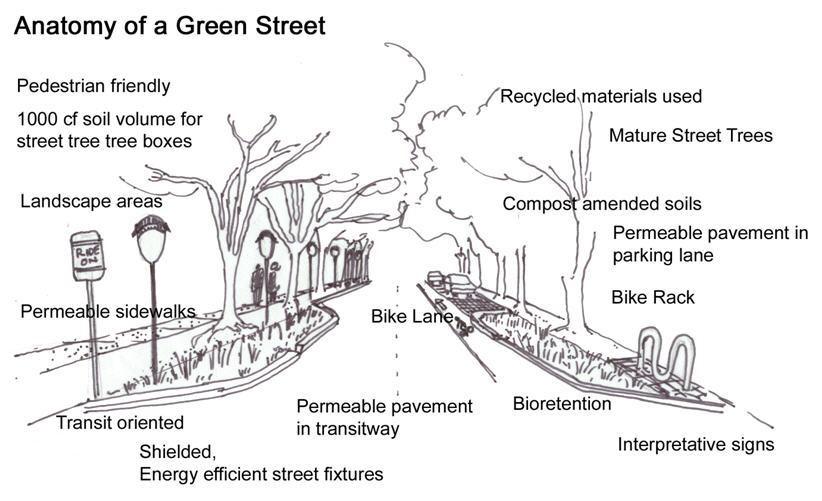Learn About Green Streets
On this page:
What is a Green Street?
A green street is a stormwater management approach that incorporates vegetation (perennials, shrubs, trees), soil, and engineered systems (e.g., permeable pavements) to slow, filter, and cleanse stormwater runoff from impervious surfaces (e.g., streets, sidewalks). Green streets are designed to capture rainwater at its source, where rain falls. Whereas, a traditional street is designed to direct stormwater runoff from impervious surfaces into storm sewer systems (gutters, drains, pipes) that discharge directly into surface waters, rivers, and streams.
EPA's Green Streets: The Road to Clean Water Exit video highlights green streets as a technique for managing stormwater and providing other economic and community benefits. Shown are examples of green streets in localities that have worked with EPA and other partners to incorporate green streets as part of their stormwater management plans. Green features shown include permeable pavement, rain gardens, vegetative curb areas, and sidewalk trees.
Anatomy of a Green Street
Streets comprise a significant percentage of publicly owned land in most communities, thereby offering a unique opportunity to incorporate green street elements that will not only protect the environment, but can improve community health and prosperity.
Green streets incorporate a wide variety of design elements including street trees, permeable pavements, bioretention, and swales. Successful application of green techniques will encourage soil and vegetation contact and infiltration and retention of stormwater. Although the design and appearance of green streets will vary, the functional goals are the same:
- provide source control of stormwater to limit the transport of pollutants to stormwater conveyance and collection systems,
- restore predevelopment hydrology to the extent possible, and
- create roadways that help protect the environment and local water quality.
The "Anatomy of a Green Street" design graphic below provides details of green street elements. The Low Impact Design Center Exit provides a list of green street practices Exit that also support green street Design-Build concepts.

Why a Green Street?
Green streets protect water quality in rivers and streams by removing up to 90% of pollutants. They replenish groundwater supplies, absorb carbon, improve air quality and neighborhood aesthetics, and provide green connections between parks and open space. Vegetated curb extensions improve pedestrian and bicycle safety, and calm traffic.
Green streets reduce peak stormwater flows, free capacity in the pipes to carry more wastewater to the sewage treatment plant, and reduce or stop sewer backups in basements. They can eliminate the need to install or replace expensive underground collection, conveyance and treatment systems. (Source: The City of Portland, Oregon: A Green Street Overview Exit).
A green street minimizes or reduces energy costs for the community. For example, the street lights can use efficient bulbs and ballasts and be powered by an alternative energy source. A green street may minimize material cost and the carbon footprint of its construction by using locally sourced and recycled materials in its design whenever possible. Green streets also make accommodations for greener and healthier transportation such as walking, running, biking, and public transportation. Streets that incorporate all of these elements are often called Complete Green Streets Exit.
Green streets can be used to:
- Minimize stormwater impacts on the surrounding area through a natural system approach that incorporates a variety of water quality, energy-efficiency, and other environmental best practices;
- Integrate green stormwater management features to increase infiltration and/or filtration of runoff, reduce flows, and enhance watershed health;
- Reduce the amount of water that is piped and discharged directly to streams and rivers;
- Make the best use of the street tree canopy for stormwater interception, as well as temperature mitigation and air quality improvement;
- Mitigate or prevent localized flooding;
- Encourage pedestrian and/or bicycle access;
- Improve the aesthetics of a community; and,
- Increases a community’s livability.
Green Street Resources
The following provide additional information on green street design and use:
You will need Adobe Reader to view some of the files on this page. See EPA’s About PDF page to learn more.
- WERF's Green Streets Basics and Design Exit
- A Conceptual Guide to Effective Green Street Design Solutions: Green Streets (PDF) (7 pp, yy, 6 MB)
- Managing Wet Weather with Green Infrastructure - Municipal Handbook - Green Streets (PDF)(19 pp, 2 MB)
- The City of Portland Oregon: A Green Street Overview Exit
